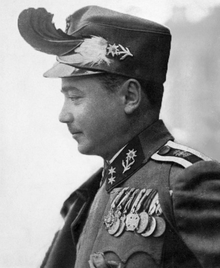Engelbert Dollfuss
Engelbert Dollfuss | |
|---|---|
 Engelbert Dollfuss 1933 | |
| Born | October 4 1892 Texing, Austria-Hungary |
| Died | July 25 1934 |
Engelbert Dollfuss (German: Dollfuß) (October 4, 1892 – July 25, 1934) was the Chancellor of Austria from 1932 until 1933.[1] He led the country as a dictator from early 1933 until 1934.
He studied law in Vienna, and Economics in Berlin. During World War I, he served in the Alps and briefly became a Prisoner of War in 1918.
He became Chancellor on May 20, 1932 as head of a right-wing coalition government. He wanted to solve the problems caused by the Depression. He had problems finding majorities in parliament. The measures he liked to take to deal with inflation were not well liked. In March 1933, he suspended the Austrian parliament. He then governed by decree.
With Adolf Hitler as Chancellor in Germany, Dollfuss feared that the influence of the NSDAP would grow. This would then lead to a growth in popularity for its Austrian counterpart. Because of this, he banned the NSDAP in June 1933. He also banned the SDAPÖ in February 1934.
In September 1933 he formed an umbrella grouping to support the regime, the Vaterländische Front (Fatherland Front) and merged the Christian Social Party with the para-military Heimwehr (Home Guard), a Nationalist paramilitary group. The regime which was put into power by him and remained in power until 1938 is often called Austrofascism. The form of state he employed was called the Ständestaat.
On July 25, 1934, eight Austrian Nazis entered the Chancellery building and shot and killed Dollfuss in an attempted coup, as a prelude to Anschluss. The Nazis surrendered and were executed. Kurt Schuschnigg became the new dictator of Austria.
References[change | change source]
- ↑ "Engelbert Dollfuss (chancellor of Austria)". britannica.com. 2011. Retrieved 20 August 2011.
Other websites[change | change source]
| Preceded by: Karl Buresch |
Chancellor of Austria | Succeeded by: Kurt Schuschnigg |
